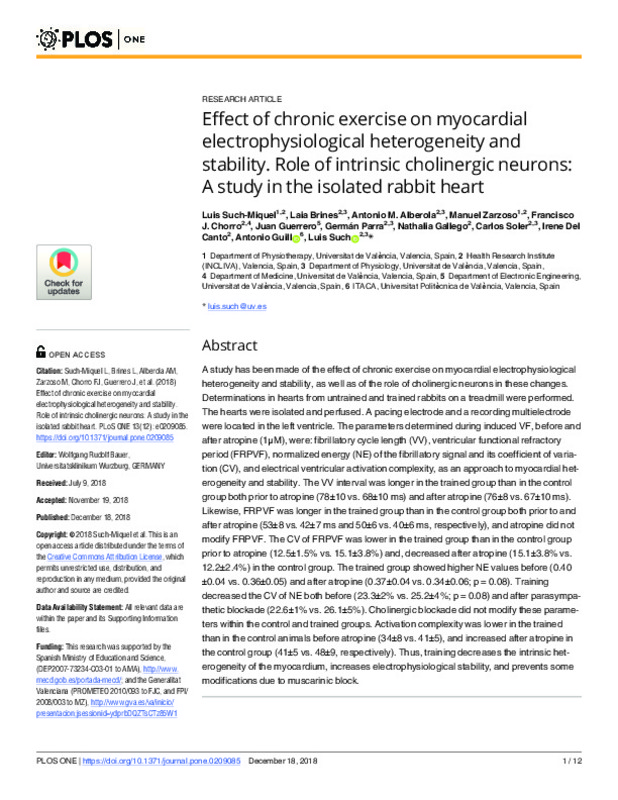Billman, G. E. (2002). Aerobic exercise conditioning: a nonpharmacological antiarrhythmic intervention. Journal of Applied Physiology, 92(2), 446-454. doi:10.1152/japplphysiol.00874.2001
Billman, G. E. (2006). A comprehensive review and analysis of 25 years of data from an in vivo canine model of sudden cardiac death: Implications for future anti-arrhythmic drug development. Pharmacology & Therapeutics, 111(3), 808-835. doi:10.1016/j.pharmthera.2006.01.002
Dor-Haim, H., Berenfeld, O., Horowitz, M., Lotan, C., & Swissa, M. (2013). Reduced Ventricular Arrhythmogeneity and Increased Electrical Complexity in Normal Exercised Rats. PLoS ONE, 8(6), e66658. doi:10.1371/journal.pone.0066658
[+]
Billman, G. E. (2002). Aerobic exercise conditioning: a nonpharmacological antiarrhythmic intervention. Journal of Applied Physiology, 92(2), 446-454. doi:10.1152/japplphysiol.00874.2001
Billman, G. E. (2006). A comprehensive review and analysis of 25 years of data from an in vivo canine model of sudden cardiac death: Implications for future anti-arrhythmic drug development. Pharmacology & Therapeutics, 111(3), 808-835. doi:10.1016/j.pharmthera.2006.01.002
Dor-Haim, H., Berenfeld, O., Horowitz, M., Lotan, C., & Swissa, M. (2013). Reduced Ventricular Arrhythmogeneity and Increased Electrical Complexity in Normal Exercised Rats. PLoS ONE, 8(6), e66658. doi:10.1371/journal.pone.0066658
Hamer, M., & Stamatakis, E. (2008). Physical Activity and Cardiovascular Disease: Directions for Future Research. The Open Sports Sciences Journal, 1(1), 1-2. doi:10.2174/1875399x00801010001
Powers, S. K., Smuder, A. J., Kavazis, A. N., & Quindry, J. C. (2014). Mechanisms of Exercise-Induced Cardioprotection. Physiology, 29(1), 27-38. doi:10.1152/physiol.00030.2013
Hull, S. S., Vanoli, E., Adamson, P. B., Verrier, R. L., Foreman, R. D., & Schwartz, P. J. (1994). Exercise training confers anticipatory protection from sudden death during acute myocardial ischemia. Circulation, 89(2), 548-552. doi:10.1161/01.cir.89.2.548
Hajnal, Á., Nagy, O., Litvai, Á., Papp, J., Parratt, J. R., & Végh, Á. (2005). Nitric oxide involvement in the delayed antiarrhythmic effect of treadmill exercise in dogs. Life Sciences, 77(16), 1960-1971. doi:10.1016/j.lfs.2005.02.015
Such, L., Alberola, A. M., Such-Miquel, L., López, L., Trapero, I., Pelechano, F., … Chorro, F. J. (2008). Effects of chronic exercise on myocardial refractoriness: a study on isolated rabbit heart. Acta Physiologica, 193(4), 331-339. doi:10.1111/j.1748-1716.2008.01851.x
Zarzoso, M., Such-Miquel, L., Parra, G., Brines-Ferrando, L., Such, L., Chorro, F. J., … Alberola, A. (2011). The training-induced changes on automatism, conduction and myocardial refractoriness are not mediated by parasympathetic postganglionic neurons activity. European Journal of Applied Physiology, 112(6), 2185-2193. doi:10.1007/s00421-011-2189-4
Billman, G. E. (2009). Cardiac autonomic neural remodeling and susceptibility to sudden cardiac death: effect of endurance exercise training. American Journal of Physiology-Heart and Circulatory Physiology, 297(4), H1171-H1193. doi:10.1152/ajpheart.00534.2009
HAN, J., & MOE, G. K. (1964). Nonuniform Recovery of Excitability in Ventricular Muscle. Circulation Research, 14(1), 44-60. doi:10.1161/01.res.14.1.44
Beaumont, E., Salavatian, S., Southerland, E. M., Vinet, A., Jacquemet, V., Armour, J. A., & Ardell, J. L. (2013). Network interactions within the canine intrinsic cardiac nervous system: implications for reflex control of regional cardiac function. The Journal of Physiology, 591(18), 4515-4533. doi:10.1113/jphysiol.2013.259382
Armour, J. A. (2008). Potential clinical relevance of the ‘little brain’ on the mammalian heart. Experimental Physiology, 93(2), 165-176. doi:10.1113/expphysiol.2007.041178
Abramochkin, D. V., Nurullin, L. F., Borodinova, A. A., Tarasova, N. V., Sukhova, G. S., Nikolsky, E. E., & Rosenshtraukh, L. V. (2009). Non-quantal release of acetylcholine from parasympathetic nerve terminals in the right atrium of rats. Experimental Physiology, 95(2), 265-273. doi:10.1113/expphysiol.2009.050302
CHORRO, F. J., CANOVES, J., GUERRERO, J., MAINAR, L., SANCHIS, J., SORIA, E., … LOPEZ-MERINO, V. (2000). Opposite Effects of Myocardial Stretch and Verapamil on the Complexity of the Ventricular Fibrillatory Pattern: An Experimental Study. Pacing and Clinical Electrophysiology, 23(11), 1594-1603. doi:10.1046/j.1460-9592.2000.01594.x
Such, L., Rodriguez, A., Alberola, A., Lopez, L., Ruiz, R., Artal, L., … Chorro, F. J. (2002). Intrinsic changes on automatism, conduction, and refractoriness by exercise in isolated rabbit heart. Journal of Applied Physiology, 92(1), 225-229. doi:10.1152/jappl.2002.92.1.225
Duytschaever, M., Mast, F., Killian, M., Blaauw, Y., Wijffels, M., & Allessie, M. (2001). Methods for Determining the Refractory Period and Excitable Gap During Persistent Atrial Fibrillation in the Goat. Circulation, 104(8), 957-962. doi:10.1161/hc3401.093156
Wijffels, M. C. E. F., Kirchhof, C. J. H. J., Dorland, R., & Allessie, M. A. (1995). Atrial Fibrillation Begets Atrial Fibrillation. Circulation, 92(7), 1954-1968. doi:10.1161/01.cir.92.7.1954
Zaitsev, A. V., Berenfeld, O., Mironov, S. F., Jalife, J., & Pertsov, A. M. (2000). Distribution of Excitation Frequencies on the Epicardial and Endocardial Surfaces of Fibrillating Ventricular Wall of the Sheep Heart. Circulation Research, 86(4), 408-417. doi:10.1161/01.res.86.4.408
Armour, J. A., Collier, K., Kember, G., & Ardell, J. L. (1998). Differential selectivity of cardiac neurons in separate intrathoracic autonomic ganglia. American Journal of Physiology-Regulatory, Integrative and Comparative Physiology, 274(4), R939-R949. doi:10.1152/ajpregu.1998.274.4.r939
Armour, J. A., & Hopkins, D. A. (1990). Activity of in vivo canine ventricular neurons. American Journal of Physiology-Heart and Circulatory Physiology, 258(2), H326-H336. doi:10.1152/ajpheart.1990.258.2.h326
D’Souza, A., Bucchi, A., Johnsen, A. B., Logantha, S. J. R. J., Monfredi, O., Yanni, J., … Boyett, M. R. (2014). Exercise training reduces resting heart rate via downregulation of the funny channel HCN4. Nature Communications, 5(1). doi:10.1038/ncomms4775
Sartiani, L., Romanelli, M., Mugelli, A., & Cerbai, E. (2015). Updates on HCN Channels in the Heart: Function, Dysfunction and Pharmacology. Current Drug Targets, 16(8), 868-876. doi:10.2174/1389450116666150531152047
Herrmann, S., Layh, B., & Ludwig, A. (2011). Novel insights into the distribution of cardiac HCN channels: An expression study in the mouse heart. Journal of Molecular and Cellular Cardiology, 51(6), 997-1006. doi:10.1016/j.yjmcc.2011.09.005
Welch, P. (1967). The use of fast Fourier transform for the estimation of power spectra: A method based on time averaging over short, modified periodograms. IEEE Transactions on Audio and Electroacoustics, 15(2), 70-73. doi:10.1109/tau.1967.1161901
[-]









